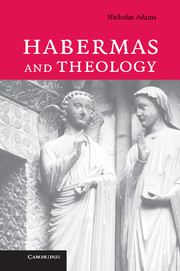Book contents
- Frontmatter
- Contents
- Preface
- 1 Religion in public
- 2 The ideal speech situation
- 3 Authority and distance in tradition
- 4 Sacred and profane
- 5 Universalism
- 6 Theology and political theory
- 7 Theology, social theory and rationalisation
- 8 Modernity's triumph over theology
- 9 Habermas in dialogue with theologians
- 10 Narrative and argument
- 11 Scriptural difference and scriptural reasoning
- List of references
- Index
2 - The ideal speech situation
Published online by Cambridge University Press: 23 December 2009
- Frontmatter
- Contents
- Preface
- 1 Religion in public
- 2 The ideal speech situation
- 3 Authority and distance in tradition
- 4 Sacred and profane
- 5 Universalism
- 6 Theology and political theory
- 7 Theology, social theory and rationalisation
- 8 Modernity's triumph over theology
- 9 Habermas in dialogue with theologians
- 10 Narrative and argument
- 11 Scriptural difference and scriptural reasoning
- List of references
- Index
Summary
The ideal speech situation is one of Habermas' best-known concepts. It is arguably the topic most cited in theological works that consider Habermas, and it is principally for this reason that it is treated first. Theologians also tend to appeal to the ideal speech situation as if it were one of Habermas' most enduring contributions to an ethics of communication. This is remarkable, as Habermas admitted problems with the concept before he wrote The Theory of Communicative Action, and it had a life of barely more than five years in his work from the early 1970s. This chapter will explain some of the general themes in Habermas' work and suggest how his ideal speech situation fits into it. There are three further reasons for considering the ideal speech situation at the start of this study, despite its brief life. First, it encapsulates some of the difficulties of Habermas' attempt to steer ‘between Kant and Hegel’. Second, it contains some of his most theologically suggestive language, especially that of ‘anticipation’: I shall consider whether this is as eschatological as it sounds. Thirdly, given that Habermas himself abandoned the ideal speech situation over twenty years ago – in name and in substance – its persistence in theologians' discussions needs explaining and challenging.
Habermas' social theory has a therapeutic goal. He aims not merely to understand social phenomena, but to alter them for the better.
- Type
- Chapter
- Information
- Habermas and Theology , pp. 23 - 48Publisher: Cambridge University PressPrint publication year: 2006

